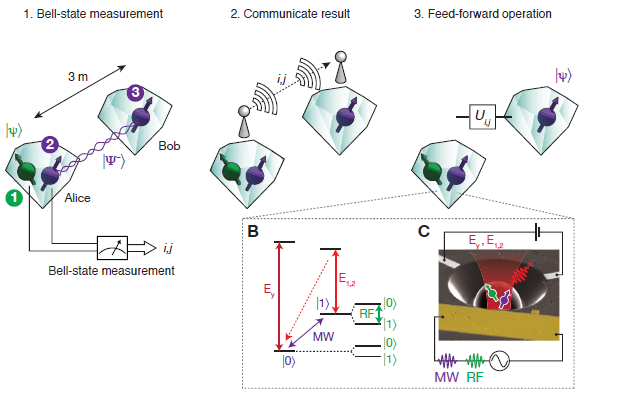Diamond Teleporters Herald New Era of Quantum Routing
The prospect of a quantum Internet has excited physicists for two decades. A quantum Internet will allow the transmission of information around the world with perfect security and make cloud-based quantum computing a reality.

But first, physicists must perfect the technology of quantum routing—the ability to receive and transmit quantum information without destroying it.
That’s a significant challenge. The key is a technique called quantum teleportation, which transmits information from one point to another without it passing through the space in between. This is a routine operation in any decent quantum optics lab but quantum routing—which concatenates the process—is another challenge altogether.
Today, Wolfgang Pfaff at the Kavli Institute of Nanoscience Delft in the Netherlands and a few pals say they’ve take a significant step toward this goal with the first demonstration of diamond teleporters that can act as nodes in a quantum network. “These results establish diamond spin qubits as a prime candidate for the realization of quantum networks for quantum communication and network-based quantum computing,” they say.
The fundamental difficulty in quantum routing is that quantum information is fragile stuff. So quantum teleportation has always involved creating a qubit, teleporting it and then immediately measuring it to check whether teleportation has been successful.
However, the process of measurement destroys quantum information. So an important goal is to create routers that can read and write quantum information without destroying it.
The process of quantum routing is to first read the stored quantum information, to then teleport it and finally to store it again ready to be teleported along the next leg of the network.
One of the most promising approaches is to store a qubit in the spin of atomic nuclei. That’s because nuclei are relatively immune from the electric and magnetic fields that can destroy, or decohere, quantum information when it is stored in electronic spins. Nuclear spins are also easy to store in crystals, unlike photons which are famously slippery and difficult to store.
So a number of groups have been working on quantum memories consisting of single atoms of things like nitrogen or phosphorous. These store information in the spin of their nucleus but can transfer it to electronic spin where it can then be passed on to a photon, for example, for transmission.
But how best to store single atomic memories in a way that allows them to be robustly controlled? One approach is to bury phosphorous atoms in silicon and then address them with an electrode on the surface. The trouble here is that these atoms tend to migrate through the silicon lattice and so get lost.
Another option is to embed nitrogen atoms in a diamond crystal and control them with microwaves. This has turned out to be more promising because the atoms are trapped more securely in the lattice and are in any case easy to spot because they fluoresce.
This is exactly the approach that Pfaff and pals have perfected at Delft. They created two quantum memories out of a pair of diamond crystals with single nitrogen atoms embedded in each. They then stored a qubit in the nuclear spin of the first crystal using microwave pulses. This is later transferred to an electron spin orbiting the nucleus.
In the process of teleportation, they create a pair of entangled photons and send one to each crystal. The interaction between the entangled photon and the stored qubit in the first crystal allows the quantum information it carries to be teleported to the second crystal where it ends up stored in the nuclear spin of the nitrogen atom there. “The source state is successfully teleported in each of the experimental runs,” say Pfaff and co.
The key thing here is that the qubit ends up stored in the second crystal, ready for transmission to yet another crystal. In other words, Pfaff and co have demonstrated the techniques necessary for quantum routing.
There are challenges ahead, of course. In these experiments, the crystals are only three meters apart but they will ultimately have to be separated by telecommunication optical fiber.
So a key goal will be to get this technique working at wavelengths suited to standard optical fiber so that it is compatible with modern communications infrastructure. That’s easier said than done.
And obviously, an important step will be routing quantum information from one node to another via a third, something that nobody has yet achieved.
In the meantime, these guys have taken a small but an important step towards robust, scalable quantum networking. “The ability to generate remote entanglement and to control and read out multiple qubits per node as shown in the present teleportation experiment makes NV centers a leading candidate for realizing a quantum network,” they say.
So having twiddle their thumbs for two decades waiting for quantum routers, perhaps physicists will not have too much longer to wait until they finally get them.
Ref: arxiv.org/abs/1404.4369: Unconditional Quantum Teleportation Between Distant Solid-State Qubits
Keep Reading
Most Popular
Large language models can do jaw-dropping things. But nobody knows exactly why.
And that's a problem. Figuring it out is one of the biggest scientific puzzles of our time and a crucial step towards controlling more powerful future models.
How scientists traced a mysterious covid case back to six toilets
When wastewater surveillance turns into a hunt for a single infected individual, the ethics get tricky.
The problem with plug-in hybrids? Their drivers.
Plug-in hybrids are often sold as a transition to EVs, but new data from Europe shows we’re still underestimating the emissions they produce.
Stay connected
Get the latest updates from
MIT Technology Review
Discover special offers, top stories, upcoming events, and more.